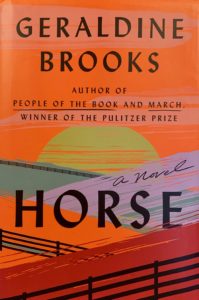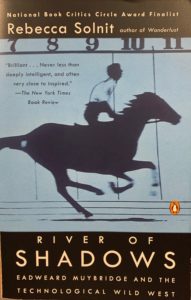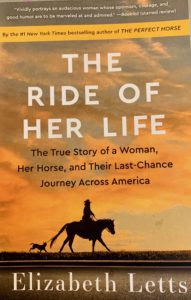Memorable Horses
 Three books I’ve read recently have taught me about loving relationships people can have with horses. It’s a kinship I’ve never had, but now greatly admire. Geraldine Brooks’s novel, Horse, is based on a Kentucky thoroughbred named Lexington, who set many records in the years just before the Civil War. In 2019 both a portrait of Lexington and the actual bones of his skull are discovered in Washington DC, where they find admiration and appreciation from two characters. Jarret was included in the artist’s portrait of Lexington that Theo found.
Three books I’ve read recently have taught me about loving relationships people can have with horses. It’s a kinship I’ve never had, but now greatly admire. Geraldine Brooks’s novel, Horse, is based on a Kentucky thoroughbred named Lexington, who set many records in the years just before the Civil War. In 2019 both a portrait of Lexington and the actual bones of his skull are discovered in Washington DC, where they find admiration and appreciation from two characters. Jarret was included in the artist’s portrait of Lexington that Theo found.
Jess, born and raised in Australia, manages the vertebrate Osteology Prep Lab for the Museum of Natural History. Jess finds Lexington’s skull in a storage room and can tell from his bones what made him special. Theo is a Nigerian-American art historian, who writes for the Smithsonian Magazine while pursuing a doctorate at Georgetown University. Theo finds Lexington’s portrait among a stack of cast-offs on his street in Georgetown. Together they learn about Jarret, the enslaved Black man shown in the artist’s portrait of Lexington. Jarret loved Lexington, understood his special abilities, and trained him to succeed as a racer and a stud horse. In the process, Jarret earns his freedom.
Though I lived in the Washington area for 47 years, often visited the Smithsonian Museums, and subscribed to the magazine, I remember little about the research that goes on in their back rooms. Brooks, whose every book I have read over the last 24 years, reveals tantalizing samples of the vast resources the Smithsonian maintains. Thank you, Geraldine Brooks, for an engrossing story.
 My friend Heather Wicke gave me the second book in 2004: River of Shadows: Eadweard Muybridge and the Technological Wild West by Rebecca Solnit. After learning more about horses and writing about the Power of Photography, I enjoyed reading it again. Muybridge, born near London in 1830, made his way to California by 1872 to photograph Occident, a fast trotting horse owned by Leland Stanford, one of the four masterminds of the transcontinental railroad that had been completed three years earlier. Stanford took pride in his trotting horse Occident and wanted photographic evidence that he could indeed have all four feet off the ground at the same time.
My friend Heather Wicke gave me the second book in 2004: River of Shadows: Eadweard Muybridge and the Technological Wild West by Rebecca Solnit. After learning more about horses and writing about the Power of Photography, I enjoyed reading it again. Muybridge, born near London in 1830, made his way to California by 1872 to photograph Occident, a fast trotting horse owned by Leland Stanford, one of the four masterminds of the transcontinental railroad that had been completed three years earlier. Stanford took pride in his trotting horse Occident and wanted photographic evidence that he could indeed have all four feet off the ground at the same time.
Muybridge produced more successful high-speed photographs than anyone had before. His 1878 camera shutters were a triumph of engineering that made reliable exposures of a fraction of a second for the first time, a speed at which extremely rapid motion could be captured in focus rather than recorded as blurs. The photographs were also a triumph of chemistry, which made the film “fast” enough to record so brief an instant. They froze motion so that the movement could be depicted as a sequence of still images.”
Muybridge also improved an earlier invention, the zootrope, so that he could project versions of his motion studies on a screen, giving rise to motion pictures. What became a huge industry in Hollywood began with photographs of a horse in San Francisco. Moving images are now an important part of how we see the world and what we remember. Thank you, Rebecca Solnit, for showing me how movies, videos and YouTube channels evolved from photos of a beloved horse.
 A third book about horses was a gift from my friend Cathie Bridwell, who, with her husband, is moving from Florida to California, but keeping their summer place in Maine. The Ride of Her Life by Elizabeth Letts, is the true story of a woman, her two memorable horses Tarzan and Rex, and her dog Depeche Toi (“Hurry Up” in French). Their journey in the mid-1950s takes them from Minot, Maine to Hollywood, California. This book brought back sweet memories of visits with Claire and Bill in Maine, with Karen and Joe in California, and of road trips with my parents, including one to Cheyenne, Wyoming, a place Annie Wilkins and her crew had visited only eight years before,
A third book about horses was a gift from my friend Cathie Bridwell, who, with her husband, is moving from Florida to California, but keeping their summer place in Maine. The Ride of Her Life by Elizabeth Letts, is the true story of a woman, her two memorable horses Tarzan and Rex, and her dog Depeche Toi (“Hurry Up” in French). Their journey in the mid-1950s takes them from Minot, Maine to Hollywood, California. This book brought back sweet memories of visits with Claire and Bill in Maine, with Karen and Joe in California, and of road trips with my parents, including one to Cheyenne, Wyoming, a place Annie Wilkins and her crew had visited only eight years before,
It was in Cheyenne that I drove over a big rock that gave us a jolt, but failed to damage our Chevy II. Annie had more serious challenges as she journeyed with her hardy animals. Reading about the places and people she encountered made me recall writing about Route 66 in 2020 and reading The Lincoln Highway by Amor Towles aloud to Steve as he drove us to North Carolin last Christmas. Most of all, it brought back fond memories of road trips with Marjo to Texas and New Mexico in 2014, to Ohio and Michigan in 2017, and last September to Oklahoma and Missouri.
My road trips have been with friends and family in comfortable cars. Annie’s 4000-mile journey was on horseback. She and her team trudged forward usually only 15 or 20 miles a day. They encountered occasional difficulties, but more often, kind and generous people offered lodging and meals. The book portrays an America that welcomed strangers, whether humans or animals, and a woman whose Maine doctor had given her only two years to live when she was 62. She refused to give up her dream of seeing California and died in 1980 at the age of 88.
You could think about everything Annie lacked: no parents, no children, not much health, only six years of schooling. No insurance, no bank account, no home. But she chose to focus on what she did have: Courage, Loyalty. Love in abundance. New friends throughout the country. A belief that she should just keep going. A sense of humor. A tolerance for meager things–jail cell cots, straw-bale mattresses, thin soups.
With those positive attributes she found herself at ease with sheriffs and mayors in small towns, Associated Press reporters, the Governor of Idaho, and Art Linkletter, the entertainer who featured her on his game show, People Are Funny, in April 1956. The author reconstructed Annie’s journey from diaries Annie kept, accounts in local newspapers, and many miles of driving her backroads route. Thank you, Elizabeth Letts–it was a great ride!
Leave a Reply